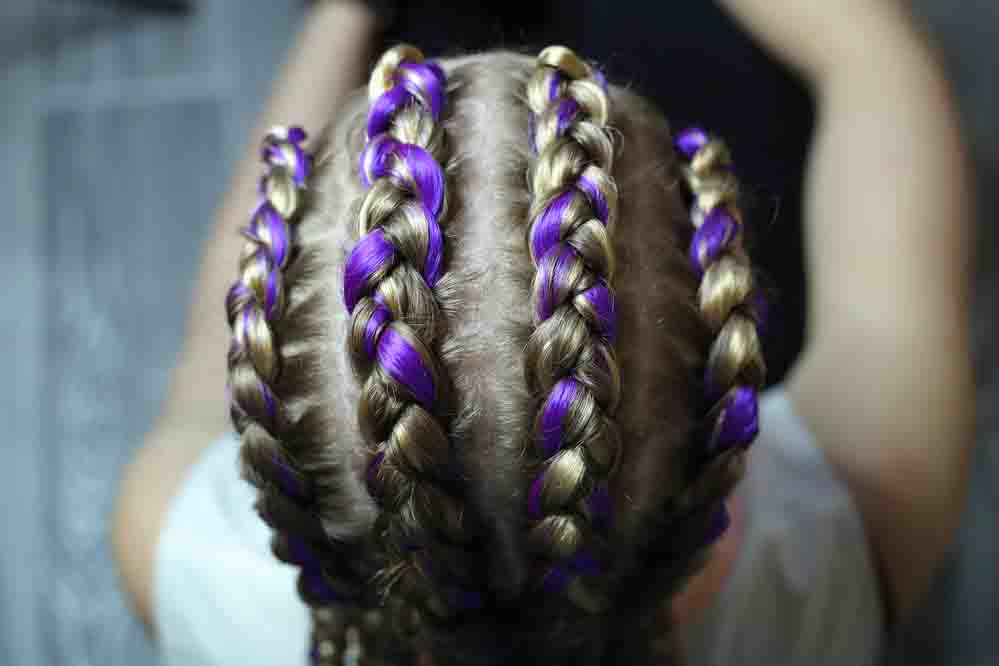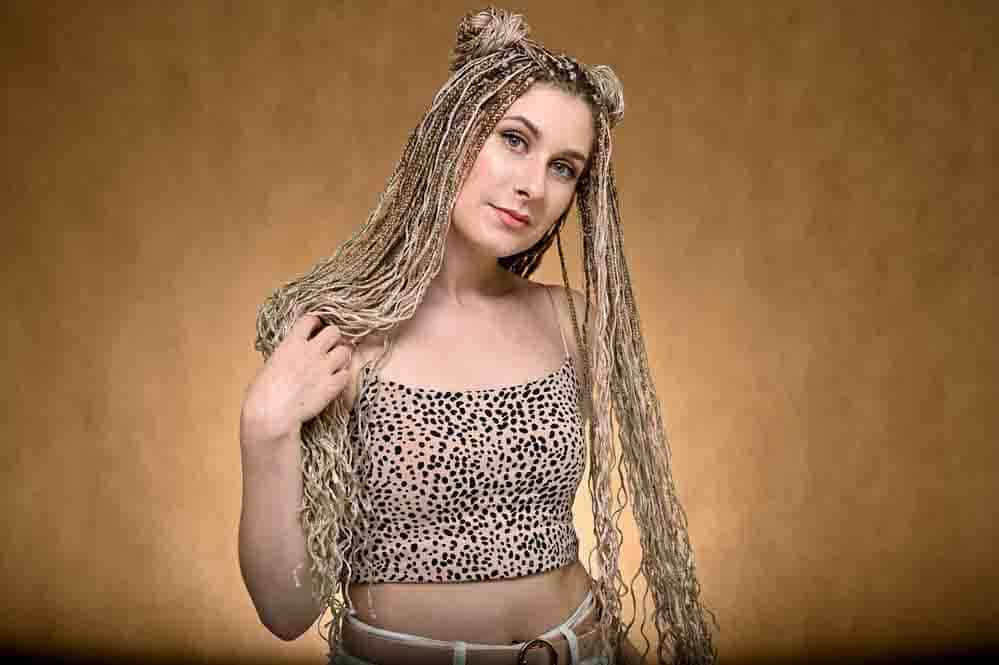Weaves and braids are amazing alternates of everyday styling and blow drying. But most people don’t know that these are two different hairstyles.
That’s why a widespread concern regarding these hairstyles is the weaves vs braids.
Braids and weaves both need braiding your own hair. Hair extensions are often used in combination with braiding to produce an overlapping pattern, but that’s the main distinction between the two.
In contrast, weaves are put into cornrows to cover your natural hair and simulate free-flowing hair.
But that’s not all. Throughout this article, you’ll learn more about weaves and braids. So, let’s get started.
What Is Braiding Weaving?

If you want to modify your natural hair’s appearance drastically, you can use a weave instead of your hair. Hair weaves can be made from synthetic or natural hair. They’re available in a wide variety of styles and colors.
With weaves’ help, you may transform your drab locks into something more exciting. People with fine hair-like to use weaves to give their hair more thickness. Fashionable hair colors are another option to show off.
In addition, a weave is a style that calls for braiding the hair on its whole. The use of a needle is necessary since there’s so much braiding produced from one strand of hair. But weave is a somewhat pricey style that is braided from one ear to the other from the back of the head with the help of hair extensions.
What Is The Difference Between Braid And Weave?

As we already mentioned, braid and weave are just different forms of braiding. And that’s why they certainly have a different stand. However, using hair extensions, your natural hair will be braided so that it can form overlapping braids.
But weaves will be sewn onto cornrows to cover real hair that’ll resemble the free-flowing hair.
How Much Do Weaves And Braids Cost?
Braiding will cost anywhere from $100 to $300, not counting the cost of hair extensions, although they can be had for as little as $4 to $12 per pack on average.
Since they’ll take longer to complete, the longer hair and thinner the braiding, the more costly they will be to complete. The majority of salons bill per hour.
However, the cost of getting your hair braided varies tremendously depending on where you live, whether you go to a professional or just a random woman down the street.
Due to the fact that your hair must first be braided into cornrows before an eave can be stitched to them, having a weave sewed into your hair often costs between $100 and $600, excluding hair extensions.
You may have to pay more or less depending on where you live and have your nails done. The level of expertise a hairdresser has will influence the price they charge.
While it’s true that getting a human hair weave fitted would cost at least $100 more since human hair type is far more costly than synthetic hair, the cost of the hair bundles may range from $80 to $600 on average, depending on the quality of the hair extensions.
Different Types Of Hair Weaves And Braids
Braid’s Types
Braids have been popular throughout history, and they continue to be a popular choice for hairstyles today. There are many different types of braids, including twists, and French braids. Some of the braid styles are given below.
CROWN BRAID
A crown braid is a single braid that forms a halo around your head. Of course, it helps if your hair is long enough to wrap around your head. Crown braids can be worn with or without a durag, but they are typically worn with one to keep the hair in place and to prevent the hair from frizzing.
BOX BRAIDS
Hair is parted in a checkerboard pattern and braided downward. Nevertheless, styling your braiding into an updo, do a braid-on-braid style or add accessories. Box braids are a great hairstyle for swimming because they keep your hair out of your face and prevent it from getting tangled. This is a very unique process that you can add to your everyday styling.
CORNROWS
This is a classic style that may be interpreted in several ways. The hair is braided down onto your head, twisting outward so that the braids you produce are elevated and tightly linked to your head.
Types of weaves
SEWING
Cornrowed hair is put onto the braided hair after wefts have been sewn onto the braided hair.
FUSION
In order to bind the weaves to your natural scalp, keratin-protein linkages are formed in each part of your hair.
INTERLOCKING
Interlocking is the combination of many sewing methods performed without the need of a cornrow. Your loose hair is sewn together with a micro-thin weft in this hairstyle.
BONDING
Hair wefts are attached to the shaft of your hair to create this look.
How Long Does It Take To Install The Braid And Weave?

Weaves and braids are two totally different hairstyles. Because of that, the installation time will definitely vary.
Typically 3 to 6 hours are required to get a full weave. However, it’ll depend on how much natural hair you have and who’s doing your weaves. Moreover, you can do a half weave that’ll take approximately 3 hours per the requirements mentioned above.
Nevertheless, there’re some more factors that have an impact on the installation time, for example, the thickness, texture and the types of hair extensions you’re getting.
Hair braiding will take 3 hours for thicker, shoulder-length braids to 10 hours for thinner, lengthy strands.
Other factors that influence the length of time it takes to install braiding include the level of expertise of your braider, the number of individuals who are braiding your hair, and the style of braids you are having.
How Long Do Weaves And Braids Last?
Depending on your braids’ style and how well you care for your natural hair and braiding, braids may last anywhere from two weeks to eight weeks.
You can easily prevent and avoid the buildup of oils and grime on the scalp and real hair with braids since they expose a larger area.
Having said that, synthetic hair extensions may also drain your hair of its natural oils more quickly, so you’ll need to be extra careful about how you care for your hair.
Now, when it comes to sew-in weaves, hairstylists say that they may be worn for six to eight weeks, provided they’re properly maintained, and your natural hair is taken care of.
How To Maintain And Take Care Of Weaves And Braids
Weave
Washing your weave and hair with mild, sulfate-free shampoos and conditioners once a week is ideal. It’s important to maintain your natural hair moisturized and nourished while your hair is braided, so don’t miss conditioning and it also helps in avoiding worn weaves.
There’ll be a lot of hair loss if you don’t completely dry your natural hair below your weave because mildew may form, harming your hair.
To style your weave on a daily basis, you’ll need to set about 30-40 minutes in the morning. Synthetic weaves need extra care since they can’t be heated without harming them. On the other hand, 100% human hair weaves may be styled just like real hair.
Braid
Braids only need to be washed once a week with light shampoos and conditioners or even a co-wash. Maintaining the health of your braiding requires regular moisturizing, at least three times a week. Moreover, it’s super easy to moisturize to avoid curling or build-up.
With braids, you can easily wash and dry your hair at home without worrying about mildew. Also, your scalp is more exposed, allowing your hair to acquire more nutrients.
Pros and Cons of Both Styles
For Hair Weave
PROS
After years of styling, perming, and colouring, your hair is damaged and fragile. The use of a hair weave might allow your hair to recuperate between salon treatments in your daily lifestyle.
As soon as you tie a weave to your hair, it absorbs all of the damage that your hair would have received from the products and styling equipment.
CONS
Having a weaved styles might cause some ladies to endure discomfort and they can’t stand by it. You’ll need to have your hair braided near to the scalp by your hairdresser before they can stitch hair tracks into the woven braids.
Some women find the braiding and stitching to be excruciating, particularly if they are delicate.
For Wearing Braids
PROS
Your hair is less likely to break if it is braided since there’s less friction. As a bonus, it keeps your hair under control and more manageable, so you wake up with fewer knots and snarls than you did before. Thus you’ll save more time in your day-to-day lifestyle.
CONS
Excessive pulling on hair follicles can lead to tensile stress in tightly braided hair. Depending on the degree of tightness or weight, these braids may be devastating. Moreover, stress can damage the follicle and lead to hair loss.
Which Is Better – Weaves Or Braids?
Both these protective styles are amazing and required same amount of efforts no doubt about that. But if you ask which one is better, that’ll depend on some factors.
For example, braiding requires a lot more work and money than weaves. So. Clearly, if you’re on a tight budget and schedule, opt for weaves.
Weaves can also be damaging to wet hair, so if you’re looking for a hairstyle that will be gentle on your locks, braids are the way to go.
If you have heavier hair, then braids may be a better option because they can help to distribute the weight more evenly.
However, if you’re more concerned about your real hair and want to keep your natural hair good, then braiding is better than weaves. So go with the style that meets most of your requirements.
But at the end of the day, the decision of which style to choose is a matter of personal preference
Are Weaves And Braids Making Us Bald?
A kind of baldness known as Central Centrifugal Cicatricial Alopecia (CCCA), which begins at the center of the scalp and extends outward toward the hairline, can be caused by hairstyles like braids and weaves.
FAQs
A braid can last from two to eight weeks, depending on what kind you choose and how you wear it. You should clean your hair every two to three weeks.
As a general guideline, leave your braided hair in for no more than 8 weeks at a time in order to preserve the health of your scalp and hair. However, consult with your stylist to establish how long your individual braids should be in.
It’ll practically be on an incline if you keep your weave in for so long. So your hair will look thick, won’t lie flat, and now you must cover it with caps or style it in enormous curls to look presentable.
Use a leave-in conditioner and natural oil to keep your braids moisturized. Massage the conditioner into your hair from your scalp to your ends using your hands. Apply a natural oil like coconut or almond after you’ve applied the leave-in conditioner.
What differentiates the two styles is how extensions are applied. The crochet technique uses a crochet needle to catch stray hair, draw it under a cornrow, and then knot it to hold it in place.
A mildew smell can occur if the braids are not properly maintained. Be sure to wash and condition your hair regularly to avoid this issue.
You can definitely wear a wig or weave over your dreadlocks. In fact, many people do this in order to protect their locs and keep them healthy.
Faux locs are more flexible than braids- they can be worn in more situations and will bounce back into shape if they get wet. A braid usually looks the best when it is freshly installed, but over time the tension on the hair can cause it to look less sleek.
Hair grows better in braids due to the protective style that helps prevent breakage and promotes hair retention.
Some of the least damaging braids are crochet braids, box braids, and knotless braids, as they put less stress on the hair and scalp.
Disadvantages of weave hair extensions include potential damage to the natural hair, discomfort, and difficulty in maintaining proper hygiene.
Weave braids can typically be kept in for 4-8 weeks, depending on the type of weave and the care provided.
Wearing a weave can be uncomfortable for some individuals, especially if it is too tight or improperly installed, leading to scalp irritation or pain.
some popular weave options commonly chosen by many individuals include sew-in weaves for a natural and secure result, lace frontal/closure weaves for a realistic hairline, 360 lace frontal weaves for versatile styling, full lace wigs for a natural-looking hairline, clip-in extensions for easy and quick installation, quick weaves for a more affordable option, and crochet weaves for quick and versatile styling with potential maintenance requirements.
Weaves typically last for approximately six to twelve weeks, depending on the type of weave and how well it is cared for.
Weaves are not considered fake hair, as they are made from human or synthetic hair and are used to enhance or alter the appearance of natural hair.
Weaves are not limited to any specific race or hair type, and individuals of any ethnicity can get a weave.
A weave is a method of attaching hair extensions to natural hair, typically by sewing, bonding, or clipping, to achieve desired length or volume.
Braids and weaves are not the same thing; braids involve interweaving sections of natural hair, while weaves involve adding extensions to the hair.
Hair weaves can be attached using various methods such as sewing, bonding, or clipping, depending on the desired style and longevity.
Weaves can be considered a protective style as they provide a barrier against manipulation and environmental damage, allowing natural hair to grow.
Weaves can be used with different hair types, including straight, wavy, curly, or kinky hair, depending on the desired outcome.
three of the most commonly known types of braids are the three-strand braid, which is the simplest type of braid; the French braid, which incorporates additional strands of hair as you braid, giving it a woven look; and the Dutch braid, which crosses the strands under each other, creating a raised 3D effect on top of the hair.
Weaves involve attaching wefts of hair through braiding and are typically done by professionals, lasting several weeks to months. Hair extensions are individual strands attached using different methods and offer more flexibility in styling, but may require less time for installation compared to weaves. Both options offer a variety of hair types, colors, and textures to match natural hair.
Four different types of weaves commonly used are sew-in weaves, clip-in weaves, bonded weaves, and fusion weaves, each with its own application method and longevity.
Weaves can potentially be damaging to natural hair if not installed, maintained, or removed properly, leading to hair breakage or traction alopecia.
Weaves are not the same as fake hair, as they involve adding hair extensions to natural hair, whereas fake hair refers to synthetic or artificial hair.
Three basic types of weaves commonly used are partial weaves, full weaves, and lace closure weaves, each with its own coverage and installation technique.
A weave is a method of attaching hair extensions to natural hair, typically using weaving techniques such as sewing, bonding, or clipping, to achieve a desired style or length.
Yes, braiding hair can be used as extensions in a weave, depending on the desired look and technique used.
The most common type of weave is the sew-in weave, where extensions are sewn onto cornrowed natural hair for a secure and long-lasting result.
A weave is different from a wig, as a wig is a complete hairpiece that covers the entire head, while a weave involves attaching extensions to natural hair.
It is possible to shower with a weave, but it is important to take care to avoid excessive moisture on the scalp, as it can cause mildew or odor.
The safest weave method depends on various factors, such as the individual’s hair type, scalp condition, and the expertise of the stylist, but methods like the sew-in weave or clip-in weave are generally considered safer options.
It is possible to sleep with a weave, but it is important to use a satin or silk bonnet or pillowcase to reduce friction and prevent damage to the hair and extensions.
There is no specific age requirement for getting a weave; it depends on individual preferences, hair condition, and parental consent for minors.
A weave on a white girl typically lasts for 6 to 8 weeks.
The worst hair extensions for your hair can vary depending on factors such as the installation method, quality of hair extensions, and maintenance, but poorly installed or maintained weaves or extensions can cause damage, such as breakage or traction alopecia.
Weave hair can get wet, but it is important to follow proper care instructions provided by the stylist to avoid damage or matting.
The level of pain experienced during a weave installation can vary depending on the individual’s tolerance and the technique used, but it should not be excessively painful.
Weave for black hair is a method of attaching hair extensions to natural hair to achieve desired length, volume, or style, and it is commonly used in the black community for protective styling and versatility.
Braids such as box braids, Senegalese twists, and passion twists are known to last longer compared to other types of braids, depending on the maintenance and care provided.
Conclusion
Hopefully, you got to know the distinction between braids Vs weaves. There’s no huge dissimilarity, as mentioned before, except for the use of extensions and the hair type. So it’ll be up to you what style you would choose depending on the budget and other factors.

